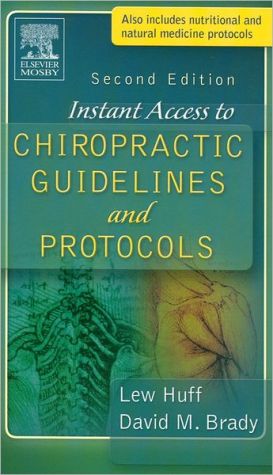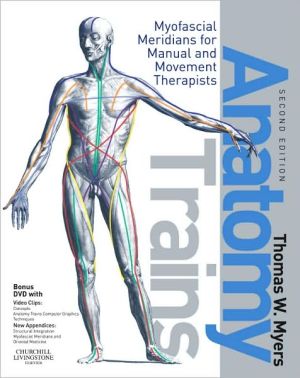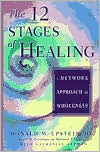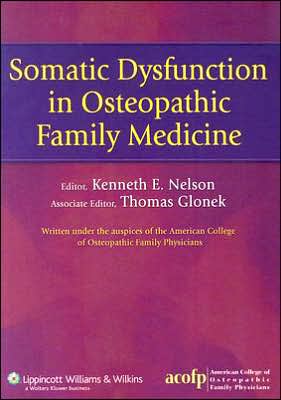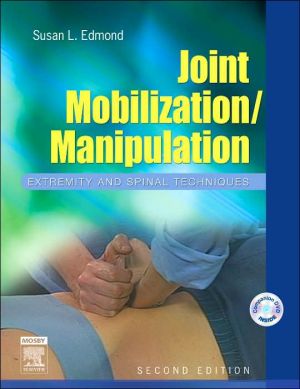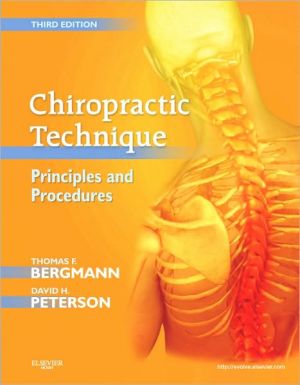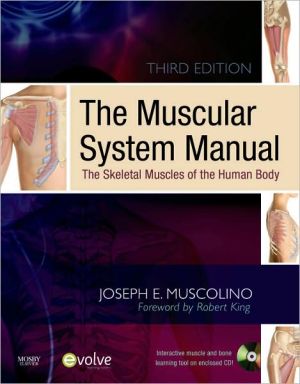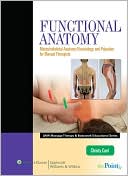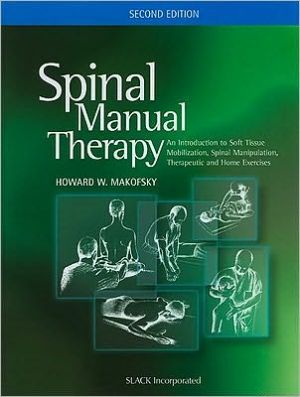Instant Access to Chiropractic Guidelines and Protocols
This one-of-a-kind, pocket-sized reference provides instant access to a wide range of key information on managing commonly encountered musculoskeletal conditions, including diagnostic criteria, treatment goals, management guidelines and protocols, nutritional management protocols, home care protocols, referral protocols, and more. Organized by orthopedic disorders, the contents are formatted for easy retrieval of pertinent information.\ • Only book to offer both diagnostic criteria, as well...
Search in google:
This one-of-a-kind pocket-sized text covers a wide range of relevant information on musculoskeletal conditions, including diagnostic criteria, treatment goals, management protocols and guidelines, protocols for nutrition management, home care, referrals, and more! Organized by commonly encountered orthopedic disorders, this convenient pocket guide gives readers quick access to pertinent information. Examination and diagnostic criteria closely follow history and examination protocols used throughout chiropractic. Sections on differential diagnosis, orthopedics, neurology, and radiography outline what a chiropractor might expect to find with any disorder. Also serves as an ideal tool for national boards review.* Presents history and examination protocols, diagnostic criteria, treatment goals, management protocols, nutritional management protocols, home care protocols, and more for each disorder. • Outlines common differential diagnosis, orthopedic, neurological, and radiographic findings. • Compiles pertinent information from landmark events such as The Rand Studies, The AHCPR Guidelines, the Quebec Task Force, The MANGA Report, and others, to create a highly reliable guide for everyday use. Dana J. Lawrence This text is a compendium of information concerning the etiology, diagnosis, and management of a wide variety of conditions that are likely to be seen and treated by chiropractic physicians. The purpose is to provide an accurate representation of scientifically valid procedures and modalities generally used and accepted throughout the chiropractic profession. The audience is mainly chiropractic physicians and students, all though physical therapists or other manual practitioners might also be interested. There are ten sections in this text, covering headaches, thoracic outlet syndromes, facial and neck pain syndromes, injuries to the shoulder, injuries to the elbow joint, injuries to the wrist, low back pain syndromes, scoliosis, lower extremity injuries, and related disorders. In addition, there are three appendixes covering nutritional product manufacturers, specialty clinical laboratories, and outcome assessment questionnaires. This is a decent attempt to codify a great deal of information, though it pales in comparison to more detailed and comprehensive textbooks. Each section entry is only a few pages long, so there is little detail presented. And there are significant omissions, such as organic diseases and various forms of cancer. There is an overabundance of information on nutrition, reflecting perhaps the bias and interests of the contributors. The text has few illustrations and dearly needs some. However, it is well referenced and these references are quite up-to-date. As a review or as an office reference, this would meet the bill. As a source text, it does not.
Cluster headaches3Hypertensive headaches10Migraine headaches15Sinus headaches22Cervicogenic cephalgia28Anterior scalene syndrome37Cervical rib syndrome42Costoclavicular syndrome47Pectoralis minor syndrome52Temporomandibular joint dysfunction59Injuries to the cervical spine : general overview64Cervical radiculopathy71Cervical spondylosis78Herniated cervical disk85Whiplash injury of the cervical spine : general overview93Hyperflexion/hyperextension injury of the cervical spine (whiplash injury of the cervical spine)98Torticollis109Injuries to the shoulder joint : general overview117Acromioclavicular joint separation/compression121Rotator cuff tear128Biceps tendon injury135Adhesive capsulitis (frozen shoulder syndrome)141Shoulder tendinitis/bursitis148Injuries to the elbow joint : general overview157Lateral and medial epicondylitis160Olecranon bursitis166Injuries to the wrist joint : general overview173Carpal tunnel syndrome177Injuries to the lumbar spine : general overview187Lumbar facet syndrome193Lumbar disk herniation203Lumbosacral strain/sprain213Sciatic neuralgia224Piriformis syndrome233Spondylolisthesis240Lumbar spinal stenosis247Scoliosis255Injuries to the hip joint : general overview263Osteoarthritis of the hip joint266Injuries to the knee and foreleg : general overview273Ligamentous injuries to the knee278Meniscus injuries to the knee285Patellofemoral pain syndrome291Anterior/posterior shin splints298Compartment syndrome304Injuries to the foot and ankle : general overview308Ankle sprain312Achilles tendinitis (achillobursitis)319Plantar fasciitis324Tarsal tunnel syndrome330Ankylosing spondylitis337Rheumatoid arthritis345Degenerative joint disease (osteoarthritis)355Diabetes mellitus362Fibromyalgia syndrome : general overview371Fibromyalgia syndrome381Hypertension392Osteoporosis398App. ANutritional product manufacturers403App. BSpecialty clinical laboratories404App. COutcome assessment questionnaires405App. DSuggested reading and references in nutritional, metabolic, and botanical medicine412
\ Dana J. LawrenceThis text is a compendium of information concerning the etiology, diagnosis, and management of a wide variety of conditions that are likely to be seen and treated by chiropractic physicians. The purpose is to provide an accurate representation of scientifically valid procedures and modalities generally used and accepted throughout the chiropractic profession. The audience is mainly chiropractic physicians and students, all though physical therapists or other manual practitioners might also be interested. There are ten sections in this text, covering headaches, thoracic outlet syndromes, facial and neck pain syndromes, injuries to the shoulder, injuries to the elbow joint, injuries to the wrist, low back pain syndromes, scoliosis, lower extremity injuries, and related disorders. In addition, there are three appendixes covering nutritional product manufacturers, specialty clinical laboratories, and outcome assessment questionnaires. This is a decent attempt to codify a great deal of information, though it pales in comparison to more detailed and comprehensive textbooks. Each section entry is only a few pages long, so there is little detail presented. And there are significant omissions, such as organic diseases and various forms of cancer. There is an overabundance of information on nutrition, reflecting perhaps the bias and interests of the contributors. The text has few illustrations and dearly needs some. However, it is well referenced and these references are quite up-to-date. As a review or as an office reference, this would meet the bill. As a source text, it does not.\ \ \ \ \ From The CriticsReviewer: Dana J Lawrence, DC, MMedEd, MA(Palmer College of Chiropractic)\ Description: This text is a compendium of information concerning the etiology, diagnosis, and management of a wide variety of conditions that are likely to be seen and treated by chiropractic physicians.\ Purpose: The purpose is to provide an accurate representation of scientifically valid procedures and modalities generally used and accepted throughout the chiropractic profession.\ Audience: The audience is mainly chiropractic physicians and students, all though physical therapists or other manual practitioners might also be interested.\ Features: There are ten sections in this text, covering headaches, thoracic outlet syndromes, facial and neck pain syndromes, injuries to the shoulder, injuries to the elbow joint, injuries to the wrist, low back pain syndromes, scoliosis, lower extremity injuries, and related disorders. In addition, there are three appendixes covering nutritional product manufacturers, specialty clinical laboratories, and outcome assessment questionnaires.\ Assessment: This is a decent attempt to codify a great deal of information, though it pales in comparison to more detailed and comprehensive textbooks. Each section entry is only a few pages long, so there is little detail presented. And there are significant omissions, such as organic diseases and various forms of cancer. There is an overabundance of information on nutrition, reflecting perhaps the bias and interests of the contributors. The text has few illustrations and dearly needs some. However, it is well referenced and these references are quite up-to-date. As a review or as an office reference, this would meet the bill. As a source text, it does not.\ \ \ 3 Stars from Doody\ \
